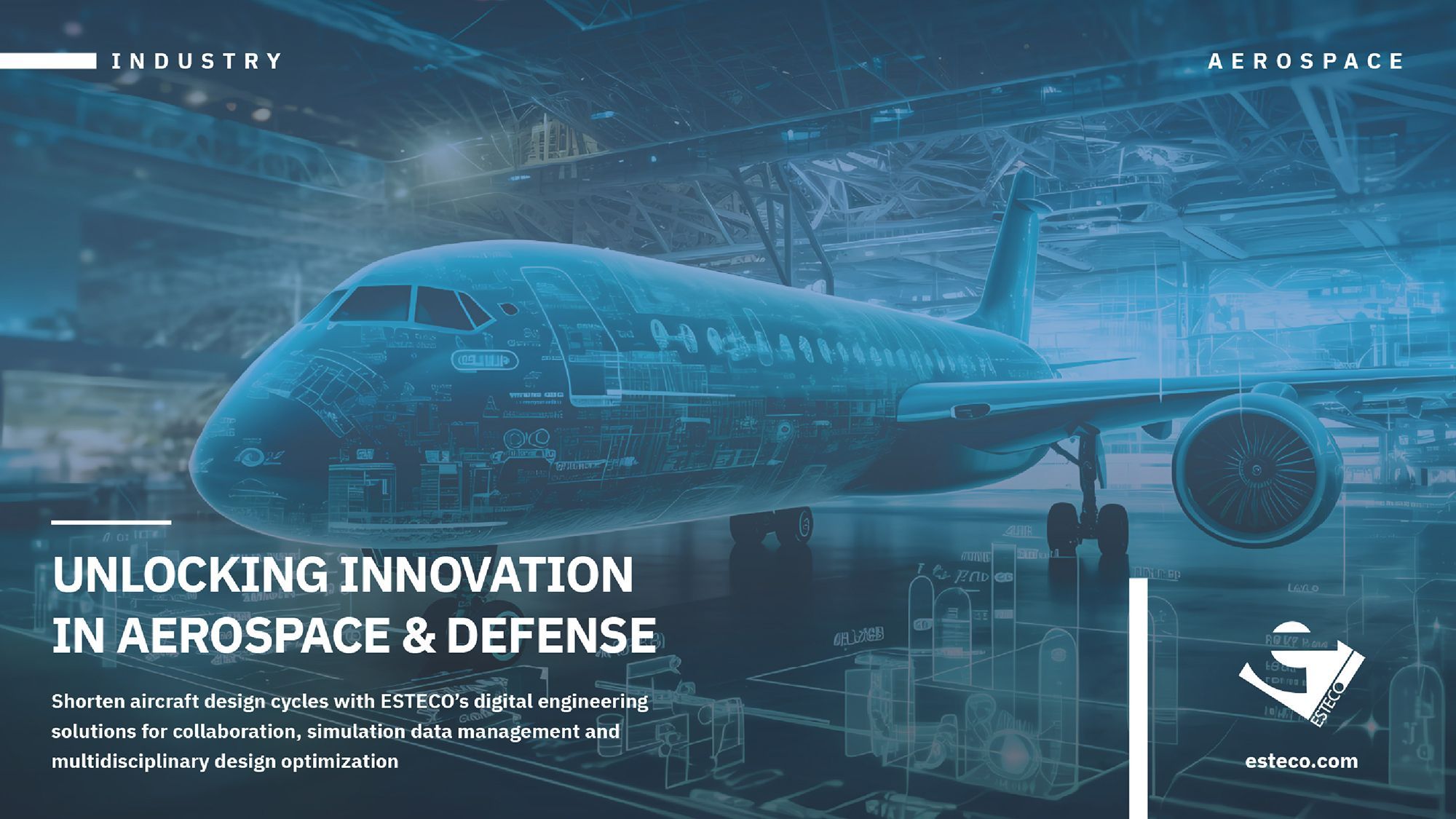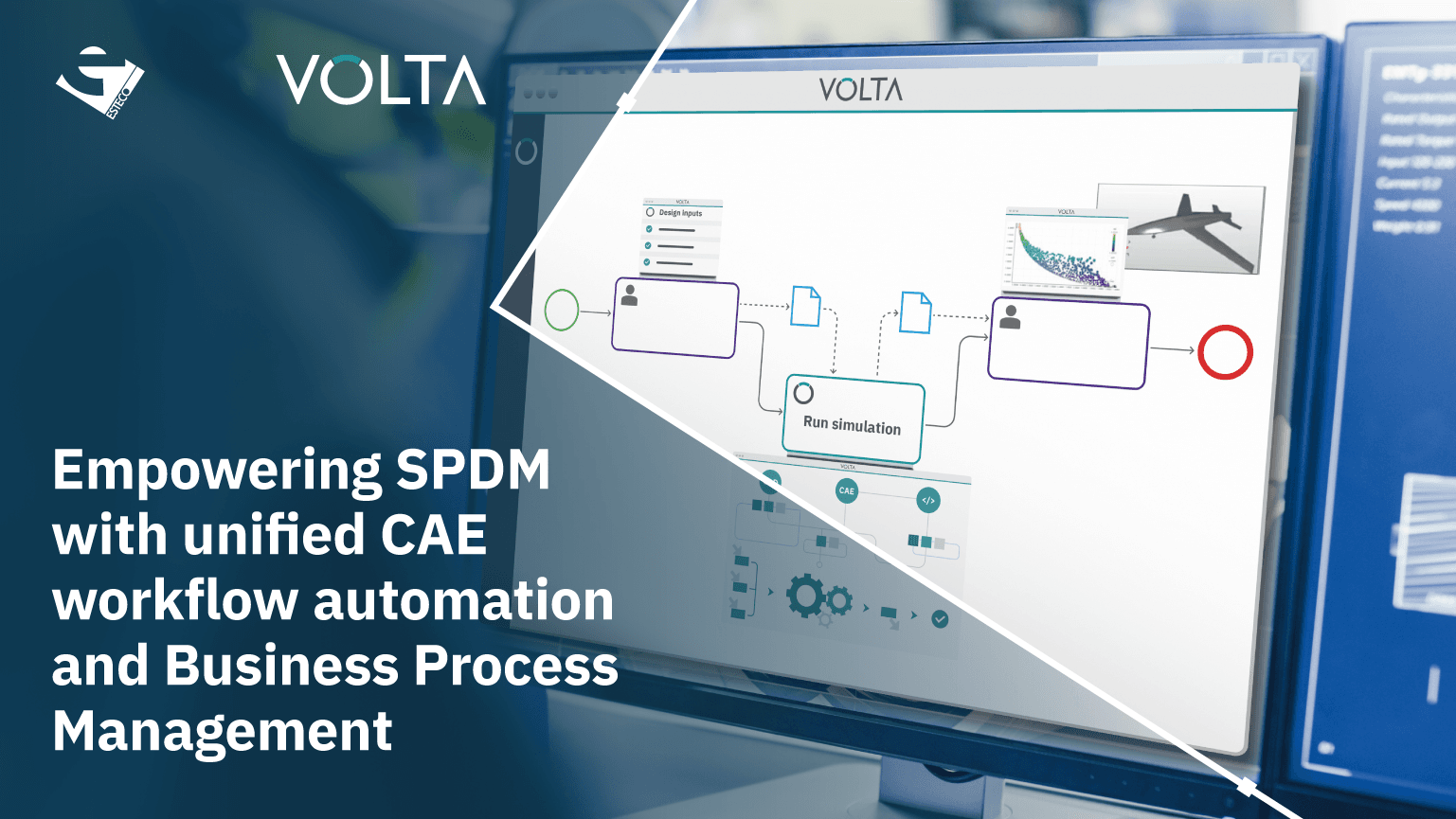eBook
Unlocking innovation in Aerospace and Defense
Shorten aircraft design cycles with ESTECO’s digital engineering solutions for collaboration, simulation data management and multidisciplinary design optimization.
Webinar
Empowering SPDM with unified CAE workflow automation and Business Process Management
Take a 30-minute deep dive into VOLTA BPM technology and learn how to automate human interactions and integrate simulation execution in a business process workflow.
All resources
Showing 101 - 110 of 126 resources
Success story
Diesel fuel efficiency takes shape with optimization
ISUZU Advanced Engineering Center (IAEC) enhances fuel efficiency by optimizing the combustion chamber design
In the debate on how best to tackle the impact of vehicles on environment, the improvement of diesel engine efficiency has emerged as a transitory but effective solution, especially for heavy-duty vehicles and passenger cars. Designers at the ISUZU Advanced Engineering Center (IAEC) have analyzed how to enhance fuel efficiency by modifying the shape of the diesel engine combustion chamber. ## Challenge
Theoretical thermal efficiency affects fuel consumption in diesel engines and one way of improving it is to increase the combustion chamber compression ratio. The resulting higher in-cylinder temperature and the expansion of the impingement area between fuel spray and chamber wall, however, can cause the chamber wall to heat up and lower theoretical efficiency. The team at IAEC looked at a new way of lowering heat loss by studying the combustion chamber shape, preventing the volumetric inefficiencies and cost and durability issues, which other methods caused.
Solution
To analyze the impact of the different chamber shapes, the team first defined the chamber outline and spray angle2 and adjusted it to match a given baseline compression ratio. The computational mesh was then created with CONVERGE CFD and modeFRONTIER was used to pilot the 3D-CFD simulations. “In this way, we were able identify the shapes with the maximum cumulative heat release and work, and – at the same time - the minimum heat loss” says Takashima, Chief Engineer Powertrain Product Planning at IAEC. ## Benefits
“The shape with the highest cumulative rate of heat release was analyzed in depth. We compared it to calculated heat release rates and cylinder gas temperature profiles of re-entrant-type and shallowdish-type chambers and, later, verified it using experimental data from a single-cylinder engine. The optimized chamber improved fuel consumption by 3.2% compared to its shallow dish type counterpart. modeFRONTIER helped us spot the optimal shape and further analyze the delicate tradeoffs regarding the thermal balance” concluded Arato.
Webinar
Integrating Prescan with modeFRONTIER for test automation of active safety systems
This webinar, hosted by ESTECO and TASS International, illustrates the successful automation of Prescan test routines by combining it with modeFRONTIER. The Automated Emergency Braking use case - originally performed manually with Matlab - demonstrates how engineers can take advantage of modeFRONTIER workflow automation capabilities and speed up the test process.
Watch this webinar to find out more about:
modeFRONTIER enhanced automation and optimization features
TASS software solution features
How to integrate the software solutions and benefit from joint analysis
Webinar
Aeroacoustic Optimization with PowerFLOW and modeFRONTIER at Jaguar Land Rover
This webinar, co-hosted by ESTECO and Exa Corporation, demonstrates the improvement of a side mirror aeroacoustic performance at Jaguar Land Rover, through PowerFLOW CFD simulation and modeFRONTIER optimization analysis.
Watch it to know more about:
modeFRONTIER enhanced optimization and integration features
Exa PowerFLOW CFD simulation advanced features
How to integrate the software solutions and benefit from joint analysis
Webinar
Optimizing the timing system on a small 2-wheeler engine with GT-Suite and modeFRONTIER
This webinar hosted by ESTECO and Gamma Technologies illustrates the benefits of integrating their technologies by focusing on a real-world industrial case.
Francesco Maiani from Piaggio & C., together with ESTECO and Gamma Technologies experts, speaks about the improvement of the timing system on a small 2-wheeler engine by leveraging GT-SUITE simulation capabilities and modeFRONTIER optimization analysis platform.
Download the case study
Watch this webinar to know more about:
modeFRONTIER enhanced optimization and integration features
GT-SUITE simulation advanced features
How to integrate the software solutions and benefit from joint analysis
Success story
Optimized Valvetrain System Boosts Two-wheeler Performance at Piaggio
Piaggio & C. s.p.a. uses modeFRONTIER optimization capabilities to improve a 125cc 4-valve engine design
The Piaggio Group is the largest European manufacturer of two-wheel motor vehicles and one of the world leaders in its sector. Headquartered in Italy and with Technology & Innovation centers located in India, China and Vietnam, Piaggio is known for its unique range of two-wheel and light transport powertrain vehicles. The company’s R&D activities focus mainly on reducing the environmental impact of its products and improving vehicle efficiency, performance and passenger safety. For many years now, Innovation & Research engineers have been using modeFRONTIER to achieve these design objectives. ## Challenge
Reducing the environmental impact of two-wheeler engines, in other words, increasing overall engine efficiency, means, amongst other things, opting for engine downspeeding or downsizing strategies, with the need of reducing engine friction; however, in order to maintain or improve vehicle performance, this requires an increase in specific engine power. The use of numerical models and calculation methodologies provide important support in pursuing these goals. In this case, the design of valve lift events and the valve train components are crucial when taking into account multiple engine issues like valve train systems stability, durability, resisting torque and engine breathing. ## Solution
Starting with the baseline valve lift profiles of a 125cc 3-valve engine, engineers at Piaggio set up an automatic workflow within the modeFRONTIER environment that piloted the GT-SUITE calculation in order to evaluate the engine performance and the valve train system behavior in relation to specific valve lift profiles. “With this automated optimization approach we were able to avoid manual, time-consuming tasks involved in modifying the valve lift event in closed loop and to gain control of the entire system behavior”, says Francesco Maiani, Engine Calculation Engineer from Piaggio & C. s.p.a. ## Benefits
“modeFRONTIER allowed us to adopt a modular approach to the problem that led us to the final valve lift event design. This methodology made it possible to define the valve lift event and support the analyst during the design of a cam profile. The optimization process sought to improve the system in terms of kinematic and dynamic characteristics and thermodynamic performance requirements”. This allowed engineers to simultaneously modify both the valve springs setup and the cam profile shapes, conveying the required response for the engine friction reduction. Additionally, the whole timing system benefitted from this procedure, also improving stability and durability.
Webinar
Multiobjective aerospace mission performance optimization with Systems Tool Kit (STK) and modeFRONTIER
This joint webinar by ESTECO and Analytical Graphics, Inc. (AGI) focuses on the integration of the two companies' technologies.
Learn how to exploit the state-of-the-art software technologies provided by ESTECO (modeFRONTIER) and AGI (STK) in an integrated approach that allows the capability to perform multiobjective studies and trade-off analysis between mission performance and cost. A demonstration will show how to set up and execute this integrated modeling and optimization process.
Agenda
Overview of Systems Tool Kit 10.1.3
Focus on the integration capabilities of modeFRONTIER and STK with optimization-related functionalities
Real world case studies:
\>> Optimization of a satellite constellation to minimize imagery revisit time and cost.
\>> Optimization of an aircraft system to maximize image resolution while minimizing observability.
Webinar
Optimizing the Polestar touring car performance with modeFRONTIER and Adams
In this webinar Per Blomberg from Polestar presents a real-world case and illustrates the optimization of a Polestar touring car performance with modeFRONTIER and Adams.
Experts Roel Van De Velde and Yijun Fan, respectively from ESTECO and MSC Software, also discuss the advantages of combining their proprietary technologies.
Download the case study | Optimization Wins the Race Against Time at Polestar.
Success story
modeFRONTIER bolsters Henniges Automotive's seal performance
Henniges Automotive uses modeFRONTIER optimization and robustness evaluation methods to improve seal design
In recent times, car sealing systems design has seen major technological advance in both materials and manufacturing techniques. Getting the design just right involves satisfying a multitude of specifications and dealing with factors that impact performance and, most importantly, requires close collaboration between the manufacturer and the customer. Henniges Automotive, a leader in vehicle sealing and anti-vibration solutions, has technical centers in North America, Europe and China that cater specifically to regional requirements. ## Challenge
Seal design must take into account various customer specifications such as low door closing effort, easy part installation, secure part retention, low glass seal drag and much more, while at the same time, satisfying both short and long-term sealing performance. Moreover, engineers need to optimize seal design to ensure robust performance under vehicle sheet metal variation as well as variations in material and geometry that occur in the rubber manufacturing process. ## Solution
Through the successful integration of MSC MARC and Altair HyperMesh in the modeFRONTIER workflow, Henniges engineers were able to automate the simulation of seal behavior with different geometry configurations. In just two days, more than 1600 design configurations were analyzed by modifying 13 grip fin variables including length, thickness, angle and location (Figure 1). “Thanks to modeFRONTIER we could consider a large amount of possibilities; an impressive result for our customers”, says Ken Ogilvie, CAE Manager. More importantly, modeFRONTIER provides Henniges engineers with the necessary tools to go through the hundreds, even thousands, of designs to find not only better but also more robust solutions. ## Benefits
“It’s difficult to make a part exactly to client specifications due to the variability in the rubber extrusion and molding process. Robustness therefore becomes very important when designing automotive seals. That’s why we choose modeFRONTIER; for its optimization and robustness capabilities,” says Fan Sheng, CAE Technical Specialist at Henniges. Looking to the future, Ogilvie says “modeFRONTIER helps us make significant improvements in the quality of our designs; without modeFRONTIER, it’s just trial and error based on past experience.”
Webinar
CubeSat satellite antenna array optimization with modeFRONTIER and CST STUDIO SUITE
This joint webinar demonstrates how to exploit the CST STUDIO SUITE electromagnetic simulation capabilities within modeFRONTIER and spot the best possible solution.
Also, hear more about:
modeFRONTIER enhanced integration features
CST STUDIO SUITE 2014 features
How to integrate the software and benefit from joint analysis
Success story
ECS System Simulation - Architecture and Performance Optimization from the Early Phases of the System Design
ECS system simulation - Architecture and performance optimization from the early phases of the system design
The trend today in aircraft thermal design leans towards electronic system integration requiring higher heat densities and a more frequent use of composite primary structures. All these factors require thermal management and architecture design to achieve a suitable robustness, even in the early design stages. The thermal architecture should be able to prevent the risks of damage to temperature-sensitive equipment and limit the expensive overdesign of aircraft systems. ## Challenge
The optimization of the thermal architecture is considered one of the key factors of future aircraft development. It requires a composite pyramid of simulation tasks to be set and managed: from equipment to aircraft section simulation to the global aircraft thermal analysis. Adopting this approach gives rise to a number of difficulties due to the variety of physical models to be integrated and the partners, techniques and tools interacting at each level of the pyramid. This case study from Leonardo’s Environmental Control System (ECS) department shows how the different design disciplines involved are handled effectively through process integration and automation, enabling the optimization of the overall performance from the early stages of system design. One of the systems considered in the ECS design at Leonardo is the air conditioning pack and distribution system. The air, supplied from the engine compressor, is processed in the conditioning pack before being distributed to the fuselage compartments. Enhancing the efficiency of the thermal architecture implies several constraints and requirements relating to standards-compliance and safety regulations. Designers must adhere to given A/C configurations and maintain suitable thermoacoustic insulation and temperature levels for both the cabin and cockpit. ## Solution
First, engineers at Leonardo used the TPM approach to compare the performance of two alternative architectures, preferring a parallel layout composed of an underfloor and a low pressure air line fed from the mixing chamber and distributing the airflow in parallel through a set of risers. Next, after building the model for the selected architecture and its subsystems in LMS.Amesim, the workflow for the air nozzle shape optimization was built in modeFRONTIER. “The optimization platform helped us reduce pressure loss and noise level to the minimum” says Gaetano Mirra (CTO, General Systems - ECS and Ice protection specialist at Leonardo). ## Benefits
“modeFRONTIER automation and integration capabilities enabled us to simultaneously consider the fluid dynamic and acoustic analysis and easily handle the data flow including Catia, StarCCM+ ans PostPRO simulations in a unique environment” continued Mirra. “We found the best configurations possible for the nozzle shape and refined the thermal architecture design, further enhancing passenger comfort in terms of cabin thermal environment”.





